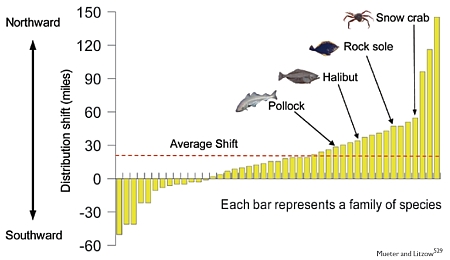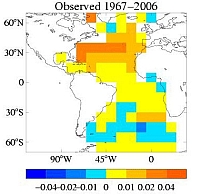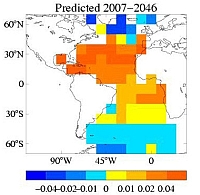4. Invasieve soorten in de oceaan
Effecten van klimaatverandering op de verspreiding van mariene uitheemse soorten
Klimaatverandering zal op verschillende manieren invloed hebben op mariene en kustsystemen. De belangrijkste aspecten zijn
- veranderde thermische regimes (in de meeste gevallen warmere watertemperaturen),
- kortere duur van de ijsbedekking,
- veranderde stromingsregimes (als gevolg van veranderingen in neerslagpatronen),
- verhoogde zoutgehalte (als gevolg van hogere luchttemperaturen, die op hun beurt leiden tot hogere verdampingssnelheden), en
- toename van waterontwikkelingsactiviteiten in de vorm van de aanleg van kanalen en reservoirs.
Al deze factoren kunnen van invloed zijn op de leefomstandigheden van invasieve soorten in de oceanen en in kustwateren zoals rivieren, kanalen en reservoirs. Sommige effecten van klimaatverandering zijn gunstig voor de verspreiding van invasieve soorten, andere kunnen juist verhinderen dat ze zich in nieuwe habitats kunnen vestigen.
De onderstaande cijfers zijn een voorbeeld van een voorspelde toename van het zoutgehalte van de oceaan als gevolg van klimaatverandering.
Veranderingen in het zoutgehalte van de Atlantische Oceaan, gemiddeld over de bovenste 500 meter zeewater.
Oranje geeft een toename in het zoutgehalte aan; blauw geeft een afname in het zoutgehalte aan.
Links: Waargenomen trends, 1967-2006, die een afname in het zoutgehalte op hoge breedtegraden en een toename in het zoutgehalte op lagere breedtegraden laten zien.
Rechts: Voorspelde trends voor 2007-2046.
Dit zijn enkele van de effecten die klimaatverandering kan hebben op mariene soorten:
- Inheemse soorten die in warm water leven, kunnen hun verspreidingsgebied uitbreiden naar de opwarmende
hogere breedtegraden en soorten die aan koude zijn aangepast, verdringen door hun grotere groei en rekrutering.
- Succesvolle indringers zijn doorgaans beter bestand tegen verstoringen dan inheemse soorten, en dus zou
klimaatverandering in combinatie met andere stressfactoren ervoor kunnen zorgen dat indringers inheemse soorten verdringen.
- De afname van koude temperaturen en/of winterhypoxie, die momenteel het voortbestaan van veel soorten
verhinderen, zou hun levensvatbaarheid kunnen verbeteren.
- De toegenomen vraag naar water zal vrijwel zeker leiden tot de aanleg van reservoirs, die op hun beurt weer hotspots voor invasieve soorten zullen worden.
De onderstaande afbeelding toont een voorbeeld van een waargenomen verschuiving van mariene soorten die hoogstwaarschijnlijk te wijten is aan klimaatverandering.

Mariene soorten in Alaska verschuiven tussen 1986 en 2006 naar het noorden.
Naarmate de lucht- en watertemperatuur stijgt, trekken mariene soorten naar het noorden, wat gevolgen heeft voor de visserij, ecosystemen en kustgemeenschappen die afhankelijk zijn van deze voedselbron. Gemiddeld is het verspreidingsgebied van de onderzochte soorten in 2006 19 mijl noordelijker komen te liggen dan in 1986.
Bron: Mueter and Litzow 2008


